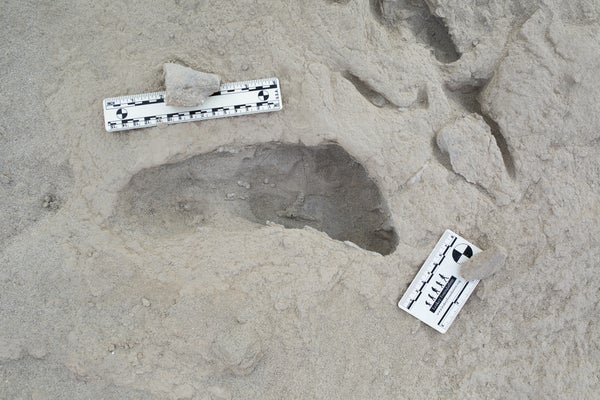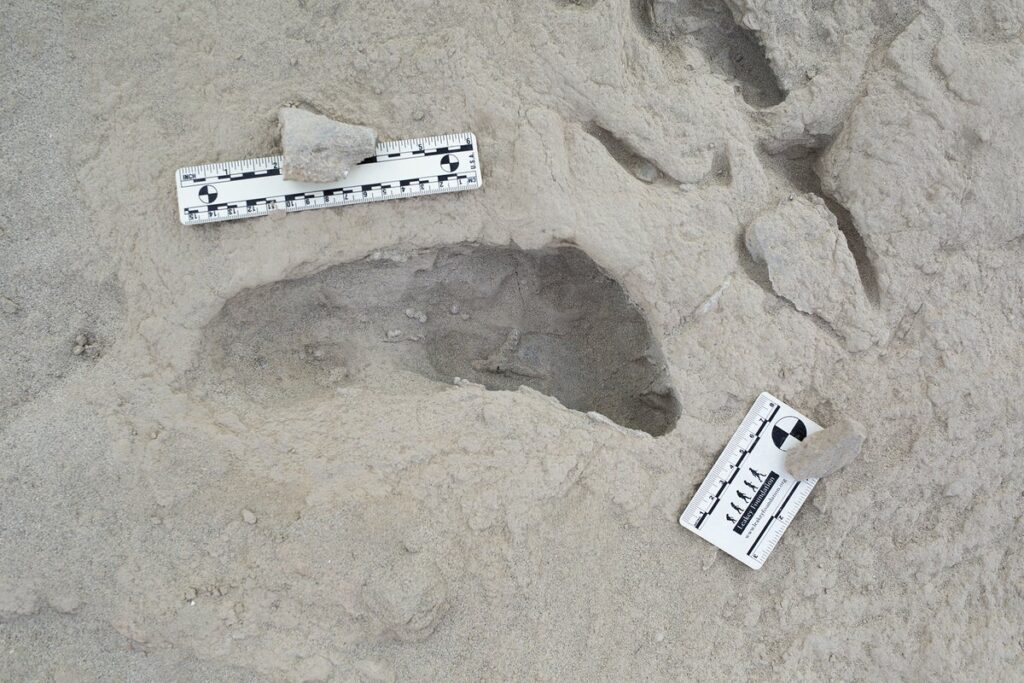[ad_1]
November 28, 2024
3 min read
Fossil Footprints Suggest Two Early Human Species Crossed Paths within Hours
Two sets of fossilized footprints from early human species were made within a few hours of each other about 1.5 million years ago, researchers suggest

Scientists think this footprint was made by a Paranthropus boisei individual.
Footprints from two different types of ancient primates related to humans—one of them a human ancestor—were likely left within hours of each other along the shoreline of a lake in what is now Kenya. The astonishing discovery of these fossilized footfalls confirms that the two hominin species lived side by side, and it offers insight into how they might have cooperated or competed.
“We didn’t know we had two species when we were excavating them,” says Kevin Hatala, a paleoanthropologist at Chatham University and lead author of a study of the footprints, which was published on Thursday in Science. “It was only after several months of analysis and ruling out all possible alternative explanations that we said, ‘We think we’ve got something special here, something that we haven’t seen before.’”
The fossil footprints were discovered in 2021 during excavations in Kenya near Lake Turkana. Over many decades, the area around the lake has yielded thousands of fossils—including many that belong to our own genus, Homo—that have been crucial to the scientific understanding of human evolution. The dozens of footprints in the 2021 find were made about 1.5 million years ago in soft sediments beside the lake, then covered by other sediments and eventually fossilized.
On supporting science journalism
If you’re enjoying this article, consider supporting our award-winning journalism by subscribing. By purchasing a subscription you are helping to ensure the future of impactful stories about the discoveries and ideas shaping our world today.
When examining the footprints, Hatala, who is an expert on the evolution of human feet, noticed that some resembled those of modern humans, whereas many others looked more primitive. He and his colleagues used three-dimensional imaging to determine the modern-looking footprints were made by an individual from the species Homoerectus, which lived between 1.89 million and 110,000 years ago and was an ancestor of modern humans.
But others were made by members of the species Paranthropus boisei—an upright hominin (extinct human ancestors and their relatives) that lived between 2.3 million and 1.2 million years ago. The species was closely related to the Homo genus but was not a direct human ancestor.
Hatala says examination of the fossilized sediments suggests the footprints were made within a few hours of each other. That timing suggests that family groups of H. erectus and P. boisei both lived near the lake and that they were both scavenging for meat from a dead animal or collecting edible plants at the same place, he says.
The study is not the first to suggest that H. erectus and P. boisei coexisted. And there are suggestions that other hominin species, including Homo habilis and Australopithecus sediba, may have also been living in parts of Africa at that time.
But this is the first direct evidence that H. erectus and P. boisei were living in the same place at the same time and that they seem to have been using the same natural resources for food, Hatala says. “These were definitely species that were around on that landscape at the same time and probably aware of each other’s existence,” he explains. However, “I think there is an open question about how they would have interacted with each other,” he adds. “They might have had a sort of low-level competition…, or maybe they were cooperating with each other. We don’t know.”
Geologist Cynthia Liutkus-Pierce of Appalachian State University, who wasn’t involved in the new study, calls it “fascinating and exciting.” Footprints are often preserved along the margins of ancient lakes and can provide glimpses of behavior that is difficult to glean from bones and stone tools, she says.
And Smithsonian National Museum of Natural History paleoanthropologist Briana Pobiner, who, with Liutkus-Pierce, studies ancient human footprints in Tanzania and also wasn’t involved in the new work, notes that the footprint analysis is critical to the paper. “Short of a time machine,” she says, “fossil footprints are the next best way to capture a snapshot in time of our ancestors’ daily lives.”
[ad_2]
Source link

